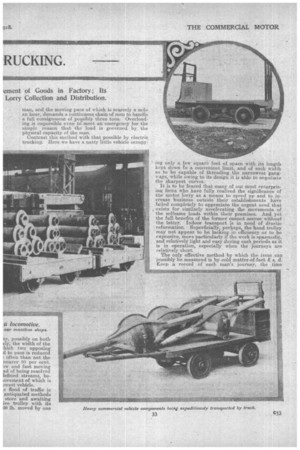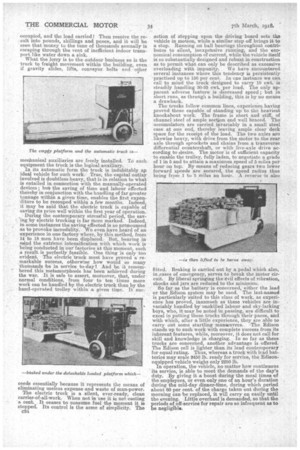ELECTRI1 RUCKING.
Page 10

Page 11

Page 12

If you've noticed an error in this article please click here to report it so we can fix it.
The New Method to Expedite Influence upon the Speeding-up
.ement 'of Goods in Factory; Its Lorry Collection and Distribution.
F THE MAN Y changes which have been wrought in our workshops and factories, particularly in the saving of time and labour, none perhaps is so striking as that pertaining to the movement of partially finished and completed goods in bulk from one part of an establishment to the other. The conveyer belt and crane are strongly in evidence, but they do not satisfactorily fulfil every requirement. . The power movement of freight in buildings to-day is being carried out by the electric truck, which for handiness and hard work could scarcely be equalled. It is completely ousting the slow and obsolete movement of goads by the old-fashioned hand-propelled • trolley, the change having been materially hastened by the prevailing dearth of labour.
. Speeding up the movement of freight within faetones and workshops is but the logical corollary of the general all-round acceleration of traffic which is such a noticeable feature of our contemporary industrial and commercial life. We hear much about the speeding up of traffic through our streets, the elaboration of complex and expensive schemes for
the relief of vehicular congestion, economical transport:, and the problem of return loads. But is a moment's reflection ever bestowed upon at least one of the contributory causes to such a State of affairs?
Traffic obstruction in our highways is materially influenced by the impediment offered by stationary vehicles loOing up and discharging their consign man, and the moving pace of which is scarcely a mile an hour, demands a continuous chain of men to handle a full consignment of polsibly three tons. Overloading is impossible even to meet an-emergency for the simple reason that the load is governed by the physical capacity of the man. Contrast this method with that possible by electric trucking. Here we have a natty little vehicle occupy jug only a few square feet of space with its length kept down Io a convenient limit, and of such width as to be 'capable of threading the narrowest 'gangways, while owing to its design it is able to negotiate the sharpest curves.
It is to be feared that many of our most enterprising firms who have fully reali7:ed the significance of the motor Terry as a means to speed up and to increase business outside their establishments have failed completely to appreciate the urgent need that exists for similarly accelerating the movements of the selfsame loads within their premises. And yet the full benefits of the former cannot accrue without the latter. Indoor transport is in need of drastic reformation. Superficially, perhaps, the hand trolley may not appear to be lacking in efficiency or to be expensive, more particularly if the work is spasmodic, and relatively light and easy during such periods as it is in operation, especially when the journeys are relatively short. The only effective method by which the issue can possibly be measured is by cold matter-of.fact s. d. Keep a record of each man's journey, the time occupied, and the load carried ! Then resolve the result into pounds, shillings and pence, and it will be seen that money to the tune of thousands annually is escaping through the vent of inefficient indoor transport like water down a sink. What the lorry is to the outdoor business so is the truck to freight movement within the building, even if gravity slides, lifts, conveyor, belts and other
mechanicalauxiliaries are freely installed. To such equipment the truck is the logical auxiliary. In its automatic form the truck is indubitably ap ideal vehicle for such work. True, the capital outlay involved is doubtless heavy, that is in relation to what is entailed in connection with themanually-operated devices ; but the saving of time and labour effected thereby in conjunction with the handling of far greater -tonnage within a given time, enables the first expenditure to be recouped within a few months. Indeed, it may be said that the electric truck is capable of saving, its price well within the first year of operatien.
During the contemporary stressful period, the say .,
ing by electric trucking is far More marked. Indeed, in some instances the saving effected is so pronounced as to provoke increchility.' We even have heard of an experience in one factory where, by this method, from 14 to 18 men have been displaced. But, bearing in mind the extreme intensification with which work is being conducted in Our' factories at this moment, such a. result. is perfectly feasible. One thing is only too evident. The electric truck must have proved a remarkable success, otherwise how would SQ many 'thousands be in. service to-day ? And be it remembered this metamorphosis has been achieved during the war. It is safe to assert, moreover, that, under normal conditions, from four to ten times more work can be handled by the electric truck than by the hand-operated trolley within a given time. It sue
ceecis essentially because it represents the means of eliminating useless expense and waste of man-power.
The electric truck is a silent, ever-ready, clean carrier-of-all-work. When not in use it ia not costing a cent. It -ceases to consume fuel the moment it is stopped. Its control is the acme of simplicity. The
C34
action of stepping upon the driving board sets the vehicle in motion, while a, similar step off brings it to a stop. Running on ball bearings throughout contributes to silent.", inexpensive running, and the economical consumption of current, while the vehicle itself is so substantially designed and robust in construction as to permit what can only be described as excessive overloading with impunity. We have encountered several instances where this tendency is persistently 'practised up to 150 per cent. In one instance we can call to mind the truck designed to carry 10 cwt. is steadily handling 30-35 cwt. per load. The only apparent adverse feature is decreased speed ; but in short runs, as through a building, this is by no means a drawback.
The trucks follow common lines, experience having proved these capable of standing up to the heaviest knockabout work. The frame is short and stiff, of channel steel of ample section and well braced. The accumulators are carried invariably in a small steel case at one end, thereby leaving ample clear deck space for the receipt Of the load. The two axles are likewise heavy, with drive from the Motor to the rear axle through sprockets and chains from a transverse differential countershaft, or with live-axle drive according to desire. The motor is of sufficient capacity to enable the trolley:, fully laden, to negotiate a grade of 1 in 5 and to attain a maximum speed of 5 miles per houron top. By means of reducing gears two lower forward speeds are secured-, the speed radius thus being from to 5 miles an hour. A reverse is also
fitted. Braking is carried out by a pedal which also, in cases of emergency, serves to break the motor circuit. By liberal springing the dvil effects of vibration, shocks and jars are reduced to the minimum. So far as the battery is concerned, either the lead or the Edison system may be used. The last-named is particularly suited to this class of work, as experience has proved, inasmuch as these vehicles are invariably handled by unskilled labour and sky-larking boys, who, it may be noted in passing, are difficult to excel in putting these trucks through their paces, and with which, after a little experience, they are able to carry out some startling manceuvres. The Edison stands up to such work with complete success from its inherent features, while, moreover, it does not call for skill and knowledge in charging. In -so far as these trucks are concerned, another advantage is offered. The Edison cell is lighter than its lead contemporary for equal rating. Thus, whereas a truck with lead batteries may scale 2450 lb. ready for service, the Edisonequipped vehicle weighs only 2250 lb. In operation, the vehicle, no matter how continuous
• its service, is able to meet the demands of the day's duty. By giving it a boost during the meal times of the employees, or even only one of an hour's duration during the mid-day dinner-time, during which period about 60 per cent. of the charge taken out during the morning can be replaced, it will carry on easily until the evening. Little overhaul is demanded, so that the periods of off-service for repair are so infrequent as to be negligible.






















